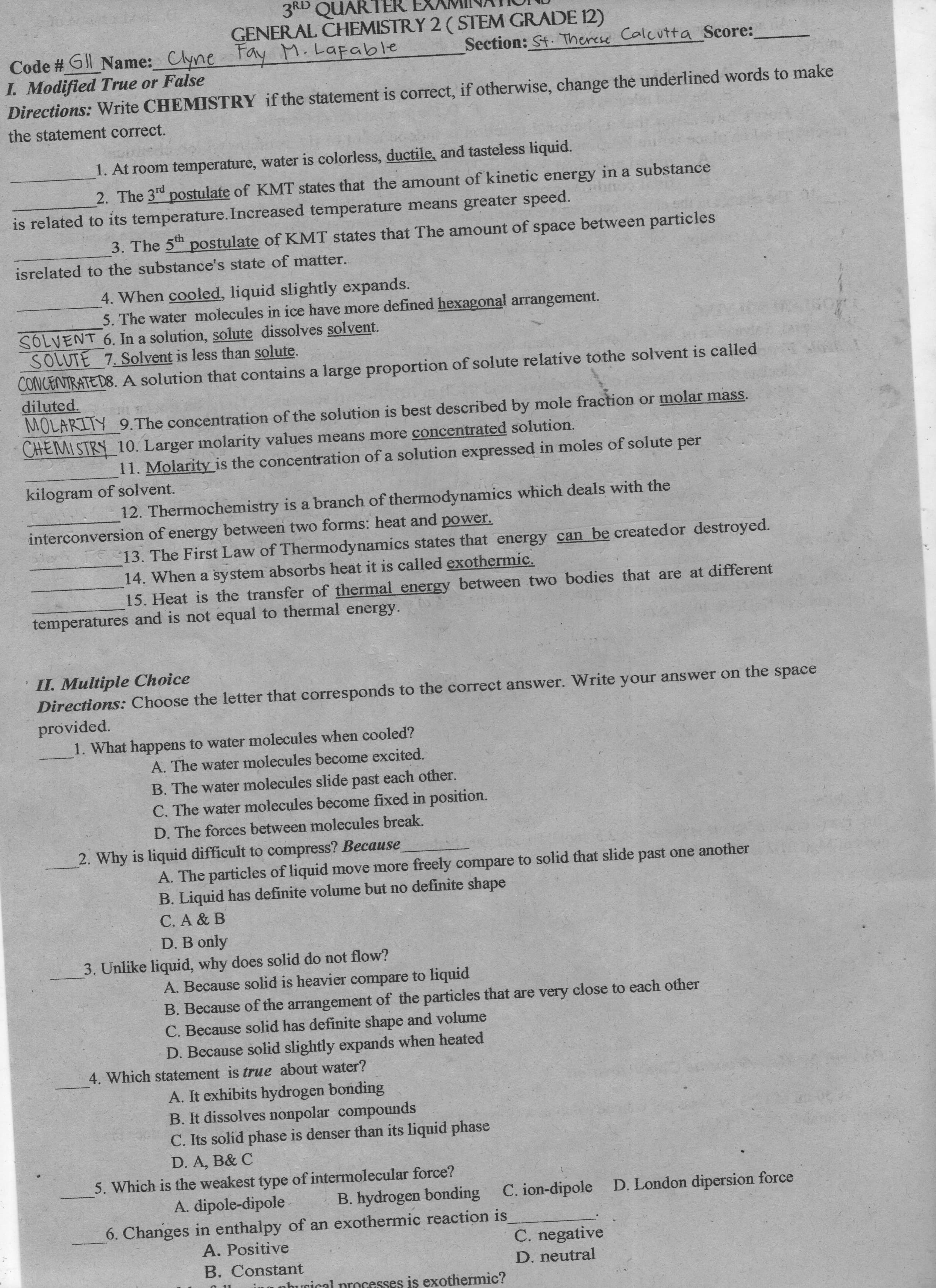II. Multiple Choice Directions: Choose the letter that corresponds to the correct answer. Write your answer on the space provided. 1. What happens to water molecules when cooled? A. The water molecules become excited. B. The water molecules slide past each other. C. The water molecules become fixed in position. D. The forces between molecules break. 2. Why is liquid difficult to compress? Because A. The particles of liquid move more freely compare to solid that slide past one another B. Liquid has definite volume but no definite shape C. A & B D. B only 3. Unlike liquid, why does solid do not flow? A. Because solid is heavier compare to liquid B. Because of the arrangement of the particles that are very close to each other C. Because solid has definite shape and volume D. Because solid slightly expands when heated 4. Which statement is true about water? It orhibits hydrogen bonding
II. Multiple Choice Directions: Choose the letter that corresponds to the correct answer. Write your answer on the space provided. 1. What happens to water molecules when cooled? A. The water molecules become excited. B. The water molecules slide past each other. C. The water molecules become fixed in position. D. The forces between molecules break. 2. Why is liquid difficult to compress? Because A. The particles of liquid move more freely compare to solid that slide past one another B. Liquid has definite volume but no definite shape C. A & B D. B only 3. Unlike liquid, why does solid do not flow? A. Because solid is heavier compare to liquid B. Because of the arrangement of the particles that are very close to each other C. Because solid has definite shape and volume D. Because solid slightly expands when heated 4. Which statement is true about water? It orhibits hydrogen bonding
Chapter6: Systems Of Equations And Inequalities
Section: Chapter Questions
Problem 17PS: Cholesterol Cholesterol in human blood is necessary, but too much can lead to health problems. There...
Related questions
Question
100%
MULTIPLE CHOICE HELP
1-3

Transcribed Image Text:3RD QUARTER EXAMIINAIOND
GENERAL CHEMISTRY 2 ( STEM GRADE 12)
Fay M.Lafable
Code # Gl Name: Clyne
I. Modified True or False
Directions: Write CHEMISTRY if the statement is correct, if otherwise, change the underlined words to make
Section: St. Therese Calcutta Score:
the statement correct.
1. At room temperature, water is colorless, ductile, and tasteless liquid.
2. The 3d postulate of KMT states that the amount of kinetic energy in a substance
is related to its temperature.Increased temperature means greater speed.
3. The 5th postulate of KMT states that The amount of space between particles
isrelated to the substance's state of matter.
4. When cooled, liquid slightly expands.
5. The water molecules in ice have more defined hexagonal arrangement.
SOLVENT 6. In a solution, solute dissolves solvent.
SOLUTE 7. Solvent is less than solute.
CONCENTRATED8. A solution that contains a large proportion of solute relative tothe solvent is called
diluted.
MOLARITY 9.The concentration of the solution is best described by mole fraction or molar mass.
CHEMISTRY 10. Larger molarity values means more concentrated solution.
11. Molarity is the concentration of a solution expressed in moles of solute per
kilogram of solvent.
12. Thermochemistry is a branch of thermodynamics which deals with the
interconversion of energy between two forms: heat and power.
13. The First Law of Thermodynamics states that energy can be created or destroyed.
14. When a system absorbs heat it is called exothermic.
15. Heat is the transfer of thermal energy between two bodies that are at different
temperatures and is not equal to thermal energy.
' II. Multiple Choice
Directions: Choose the letter that corresponds to the correct answer. Write your answer on the space
provided.
1. What happens to water molecules when cooled?
A. The water molecules become excited.
B. The water molecules slide past each other.
C. The water molecules become fixed in position.
D. The forces between molecules break.
2. Why is liquid difficult to compress? Because
A. The particles of liquid move more freely compare to solid that slide past one another
B. Liquid has definite volume but no definite shape
C. A & B
D. B only
3. Unlike liquid, why does solid do not flow?
A. Because solid is heavier compare to liquid
B. Because of the arrangement of the particles that are very close to each other
C. Because solid has definite shape and volume
D. Because solid slightly expands when heated
4. Which statement is true about water?
A. It exhibits hydrogen bonding
B. It dissolves nonpolar compounds
C. Its solid phase is denser than its liquid phase
D. A, B& C
5. Which is the weakest type of intermolecular force?
B. hydrogen bonding
6. Changes in enthalpy of an exothermic reaction is
A. dipole-dipole
C. ion-dipole D. London dipersion force
A. Positive
C. negative
B. Constant
D. neutral
is exothermic?
Expert Solution
This question has been solved!
Explore an expertly crafted, step-by-step solution for a thorough understanding of key concepts.
Step by step
Solved in 2 steps

Recommended textbooks for you


Glencoe Algebra 1, Student Edition, 9780079039897…
Algebra
ISBN:
9780079039897
Author:
Carter
Publisher:
McGraw Hill

Big Ideas Math A Bridge To Success Algebra 1: Stu…
Algebra
ISBN:
9781680331141
Author:
HOUGHTON MIFFLIN HARCOURT
Publisher:
Houghton Mifflin Harcourt


Glencoe Algebra 1, Student Edition, 9780079039897…
Algebra
ISBN:
9780079039897
Author:
Carter
Publisher:
McGraw Hill

Big Ideas Math A Bridge To Success Algebra 1: Stu…
Algebra
ISBN:
9781680331141
Author:
HOUGHTON MIFFLIN HARCOURT
Publisher:
Houghton Mifflin Harcourt